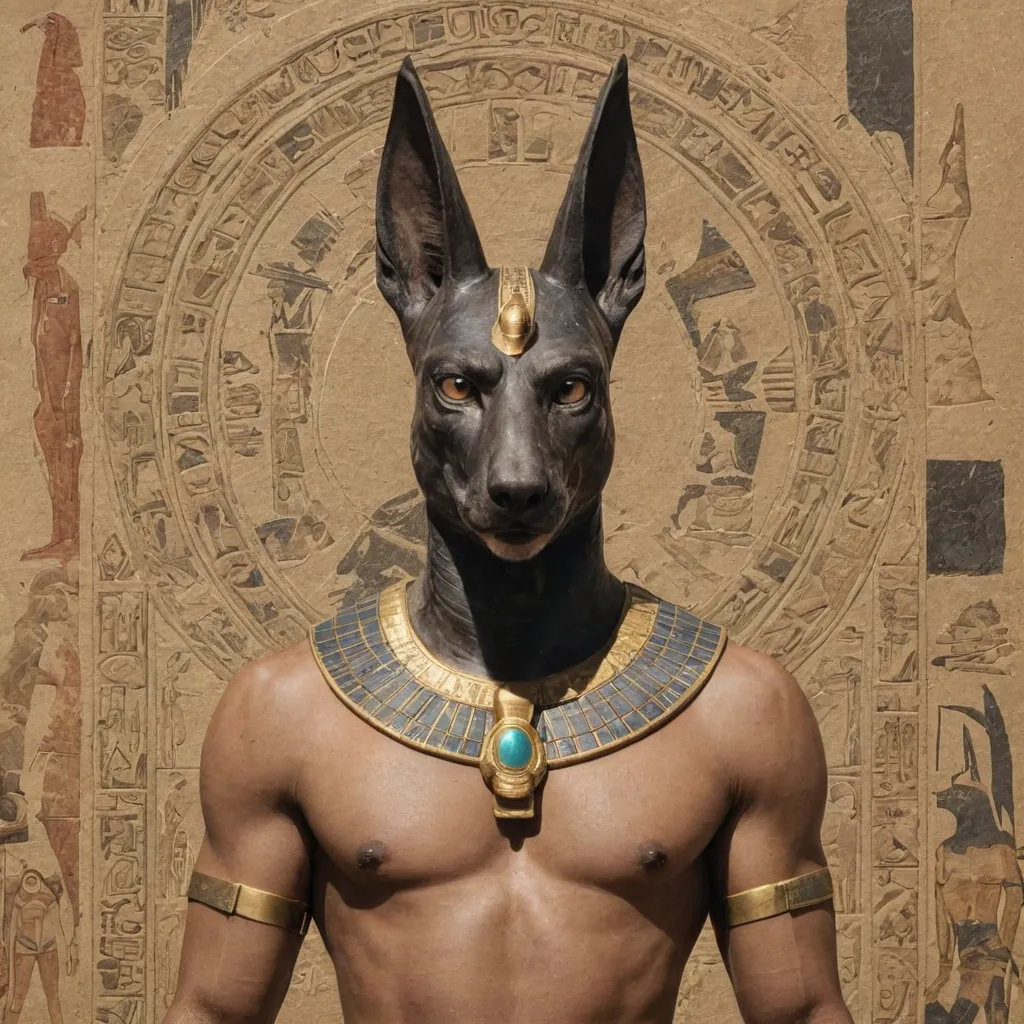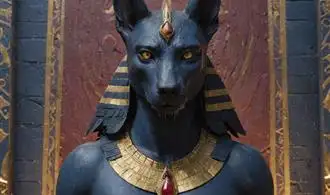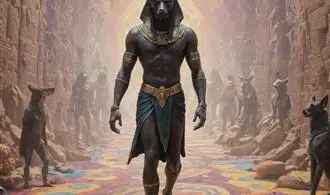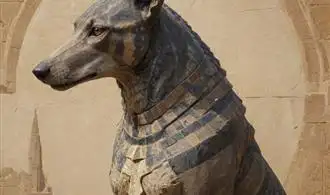
The Enigmatic Origins of Anubis
Anubis, the enigmatic jackal-headed deity of ancient Egypt, has captivated the imaginations of scholars, practitioners, and enthusiasts alike for centuries. Tracing the origins of this powerful deity is a journey through the mists of time, where mythology, archaeology, and the mysteries of the Nile converge to reveal a tapestry of intrigue and reverence.
The earliest known depictions of Anubis date back to the Predynastic period of ancient Egypt, suggesting his roots lie deeply embedded in the pre-Pharaonic traditions of the region. Scholars believe Anubis may have initially been a regional deity, worshipped by specific communities before being absorbed into the pantheon of the Egyptian gods. This transition from a localized figure to a deity of national significance is a testament to the adaptability and enduring appeal of the Anubis mythos.
Anubis' association with death, the afterlife, and the embalming process is well-documented in ancient Egyptian texts and artifacts. As the patron of necropolis and the guardian of the dead, Anubis played a crucial role in the elaborate funeral rituals that were central to the ancient Egyptian worldview. His presence at the weighing of the heart ceremony, where the deceased's soul was judged, solidified his position as a gatekeeper to the afterlife, a role that continues to captivate modern practitioners and scholars.
The origins of Anubis' iconography, characterized by the distinctive jackal or dog-like head, are a subject of ongoing debate. Some scholars suggest that this representation may have roots in the reverence for canine species, which were often associated with the desert and the wild, both of which were seen as gateways to the underworld. Others propose that the jackal-headed form may have been a symbolic representation of Anubis' role as a liminal figure, straddling the realms of the living and the dead.
Interestingly, Anubis' name itself is a subject of scholarly investigation. The Greek name "Anubis" is believed to be a Hellenized version of the ancient Egyptian name "Anpu" or "Inpu," which may have derived from the root word "inp," meaning "to decay" or "to disappear." This linguistic connection underscores Anubis' association with the processes of death and decomposition, further cementing his role as a guardian of the necropolis and the transition to the afterlife.
The Pivotal Roles of Anubis in Egyptian Mythology
Anubis, the jackal-headed deity, held a pivotal role in the rich tapestry of Egyptian mythology. Often associated with the afterlife and mummification, Anubis' influence extended far beyond these realms, shaping the spiritual beliefs and practices of ancient Egyptians.
At the heart of Anubis' significance was his role as the protector of the dead. As the guardian of the necropolis and the embalmer of the deceased, Anubis ensured the successful transition of the soul from the mortal realm to the afterlife. This responsibility was crucial, as the Egyptians believed that the preservation of the physical body was essential for the soul's journey through the underworld and eventual rebirth.
Anubis' presence was also integral to the mummification process, which was a complex and meticulous ritual that transformed the deceased into an eternal being. The jackal-headed deity would guide the embalmers, ensuring the proper preparation of the body and the invocation of the necessary spells and incantations. This role cemented Anubis' status as a figure of immense power and significance in the Egyptian pantheon.
Beyond his duties as the protector of the dead, Anubis also held court in the Anubis Predicts the Future of the Afterlife and presided over the weighing of the heart ceremony. This ritual, where the deceased's heart was weighed against the feather of Ma'at (the goddess of truth and justice), determined the individual's worthiness to enter the afterlife. Anubis, as the conductor of this pivotal judgment, played a crucial role in the fate of the soul.
Anubis' influence extended beyond the realm of the dead, as he was also associated with the more practical aspects of embalming and mummification. As the patron deity of these practices, Anubis was revered by embalmers, priests, and anyone involved in the preservation of the deceased. This connection to the physical world further solidified Anubis' status as a multifaceted and indispensable figure in Egyptian mythology.
Unlocking the Symbolic Significance of Anubis
Anubis, the enigmatic jackal-headed deity of ancient Egypt, has long captured the imagination of scholars, spiritual seekers, and devotees alike. As a modern practitioner, unlocking the symbolic significance of this powerful figure can provide invaluable insights into the realm of the divine and the deeper mysteries of the human experience.
At the core of Anubis's symbolism lies his role as the guardian of the underworld, the overseer of the sacred rituals of mummification, and the psychopomp who guides the deceased into the afterlife. This duality of death and rebirth, of the journey from the physical to the ethereal, is perhaps the most profound aspect of his iconography. By understanding the multilayered meanings woven into Anubis's iconography and mythology, we can tap into the transformative energies he embodies and apply them to our own spiritual and personal growth.
One of the most striking features of Anubis is his canine-like head, which connects him to the natural world and the primal forces that lie beyond the veil of the mundane. This animal aspect represents the instinctual, intuitive, and primordial aspects of the human psyche, inviting us to explore the deeper recesses of our own consciousness. By meditating on the symbolic significance of the jackal, we can cultivate a deeper connection to our own innate wisdom, our ability to navigate the shadowy realms of the subconscious, and our capacity for transformation.
Anubis's association with the process of mummification and the preservation of the physical body further underscores his role as a guardian of the liminal spaces between life and death. The Mysteries of Anubis Rituals Revealed delves into the sacred ceremonies and rites that were performed under the watchful gaze of this deity, highlighting the profound reverence and respect the ancient Egyptians held for the process of death and the transition to the afterlife.
Moreover, Anubis's position as the psychopomp, the guide who assists the deceased in navigating the treacherous terrain of the underworld, speaks to his role as a facilitator of transformation and transcendence. By aligning ourselves with the energy of Anubis, we can cultivate the courage, discernment, and resilience needed to confront the darker aspects of our own psyches and emerge reborn, empowered to walk the path of spiritual growth and self-discovery.
Honoring Anubis in Modern Pagan and Spiritual Practices
Anubis, the enigmatic Egyptian deity associated with death, the afterlife, and mummification, holds a profound place in modern pagan and spiritual practices. As a complex and multifaceted figure, Anubis offers contemporary seekers a rich tapestry of symbolism, rituals, and insights to explore. Whether you're a seasoned practitioner or new to the path, understanding the nuances of Anubis' role can deepen your connection to the divine and unlock transformative experiences.
At the heart of Anubis' modern relevance lies his status as a gatekeeper between the realms of the living and the dead. Many pagans and spiritualists incorporate Anubis into their practices as a guide, protector, and facilitator of the death and rebirth cycle. Rituals honoring Anubis may involve meditations on mortality, shadow work, and the navigation of the liminal spaces between life and death. By engaging with Anubis, practitioners can confront their own fears, embrace the cyclical nature of existence, and cultivate a profound sense of compassion and understanding.
Anubis' association with mummification and the embalming process also holds significance for modern practitioners. In ancient Egypt, Anubis was responsible for overseeing the preservation of the physical body, ensuring a smooth transition to the afterlife. Today, some pagans and spiritualists may incorporate Anubis' energy into practices related to personal transformation, energy work, and the cleansing or "mummification" of the self. This can manifest in rituals, spellwork, or even the creation of protective amulets and talismans.
Beyond the realms of death and the afterlife, Anubis is also honored for his role as a psychopomp, guiding souls through the underworld. In this capacity, Anubis is often invoked by those seeking guidance, protection, and a deeper understanding of the unconscious mind. Anubis Speaks - Bold Statements From the Jackal God explores the profound insights and messages that Anubis offers to the modern practitioner.
Engaging with Anubis in modern pagan and spiritual practices can take many forms, from simple devotional practices to more complex rituals and initiations. Offerings of incense, flowers, or even symbolic representations of Anubis (such as candles or statues) can be used to establish a connection and invite the deity's presence. Meditations, dream work, and divination practices focused on Anubis can also deepen one's understanding and relationship with this powerful Egyptian god.
Anubis in Art, Literature, and Popular Culture
Anubis, the enigmatic jackal-headed deity of ancient Egyptian mythology, has captivated the imagination of artists, writers, and popular culture enthusiasts for centuries. This immortal figure has transcended the boundaries of its ancient roots, leaving an indelible mark on the creative landscape. Explore the multifaceted representations of Anubis in art, literature, and popular culture, and uncover the enduring allure of this revered deity.
In the realm of art, the image of Anubis has been a source of inspiration for countless creatives. From the grand temples and tombs of ancient Egypt to the contemporary canvases of modern masters, Anubis has been depicted in a myriad of forms. Intricate wall carvings, intricate hieroglyphic inscriptions, and striking statues immortalize the deity's striking features and symbolic significance. Renowned artists have reinterpreted the Anubis motif, infusing it with their unique styles and perspectives, captivating audiences with the power and mysticism of this ancient icon.
The literary world has also embraced the enigmatic figure of Anubis. Prominent authors have woven the deity's narrative into their works, exploring the symbolic and metaphorical resonance of Anubis. In ancient Egyptian texts, the role of Anubis as the guardian of the dead and the psychopomp, guiding souls to the afterlife, is central to the understanding of the Egyptian conception of the afterlife. Contemporary writers have reimagined Anubis, incorporating the deity into fantasy, historical fiction, and even contemporary urban fantasies, breathing new life into the ancient legend.
The enduring popularity of Anubis has also found expression in the realm of popular culture. From blockbuster films to iconic comic book series, the jackal-headed deity has become a familiar and captivating figure. In Hollywood, Anubis has been depicted in epic historical dramas, where the deity's imposing presence and mythological significance add depth and authenticity to the narratives. In the world of comic books and graphic novels, Anubis has been reimagined as a powerful, enigmatic, and often complex character, resonating with audiences who seek to delve into the rich tapestry of ancient Egyptian mythology.
















